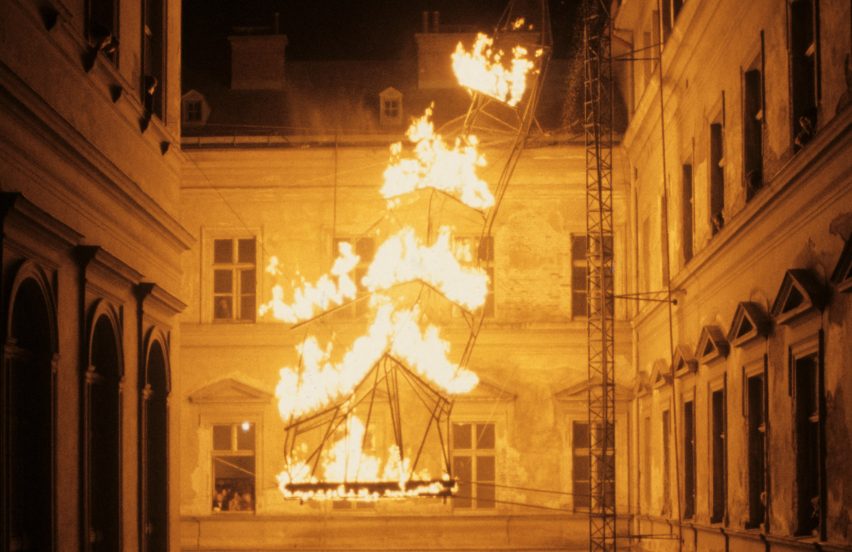
"Deconstructivism left us with the notion that architecture can be an act of continual revolution"
There are lessons to be learned from the dying embers of deconstructivism, says Aaron Betsky in this opinion piece as part of our series revisiting the style.
"Architecture Must Burn" was, as far as I am concerned, what deconstructivism was all about. I used the phrase, coined by Coop Himmelb(l)au as part of its Blazing Wing installation (pictured), for a book I wrote and believed, at least for a while, that architecture could burn.
The fire was ablaze in 1990. By now, the Coop is known for designing spectacular theaters in China and the headquarters of the European Bank, but it is questionable whether their buildings will ever burn unless a real revolution comes.
What can we learn from a movement that has been dead for so long?
Such is the way of all such attempts to establish the order of things: they are themselves assertions of a counter-order that itself becomes a center of power. The revolutionaries are left waiting, like the Futurists FT Marinetti imagined, in their old age, huddled by a fire fed by their own manifestoes and books, set upon by the next horde of iconoclasts. What can we learn from a movement that has been dead for so long? I still think there are some vital embers burning in the remains of its fire.
The proposed burning was part of an era of endings. Utopias appeared to have failed, endless progress seemed elusive, and the notion of problem-solving itself seemed problematic.
The essence of what the disparate group of people, some of whom made it into the defining Museum of Modern Art exhibition or any number of books (including my own Violated Perfection of 1992), shared was a desire, first of all, to open, tear, break and reveal. Their hero was not Le Corbusier or Ludwig Mies van der Rohe, or any the other heroes behind or after them, but figures such as the artist-trained-as-an-architect, Gordon Matta-Clark (Frank Gehry's avowed "favorite architect" at the time), who cut open buildings.
Other models they looked to included leaping whales crashing up through the surface of the seas, buildings under construction, scaffolding, train wrecks and car crashes, ruins revealed and traced, and, yes, Russian constructivist dreams of defying not only capitalism, but gravity and logic as well.
Along with the heroic tradition they also rejected (at the time) the notion of finished, logical, and functional buildings.
Deconstructivism created some strategies and tactics of enduring value
The idea that a building was a means to solve problems and serve clients, to which postmodernism only added the idea that the results should be properly and effectively communicated and scaled to a diverse audience, was crumpled up and replaced with shards, fragments, and experiments in construction and landscaping (or landscraping, or building with, not on, the land).
Deconstructivism, if that is what we must call it, produced a lot of words and arguments, and positioned some of its practitioners as future power brokers in the post-millennial design regimes of schools and offices, but it also created some strategies and tactics of enduring value. The movement, ironically, was most productive in enriching the moves, tricks, and formal vocabulary of architecture.
The tactics were as diverse as their makers (other than the fact that the latter were almost all white males). First, there was the literal deconstruction of buildings, of which Gehry was the pioneer. In this mode, the building was left or made unfinished, with materials that were humble or not meant to be seen exposed and even exalted by giving them the shapes of monumental fragments: concrete columns with no capitals, plywood used to pour concrete used as the cladding of a church, or chain link fence repurposed as a canopy in geometric abstractions, and lines of wood studs forming scrims and screens.
Second, there was the use of fragments, usually sharp and angular, piled together in a manner that was not logical – at least in terms of traditional architecture. The effect was expressive, although of what was never quite clear. This was the province of the work of rebels like those at Coop Himmel(b)lau and, at the time, Los Angeles architects such as Eric Owen Moss and Thom Mayne.
It was given a theoretical, if arcane, justification by Daniel Libeskind as a way of escaping the amorality of power relations. This was, of course, before he turned into the maker of repetitive memories of these shards for everything from shopping malls to synagogues.
Third, there was architecture as a bomb set off in the landscape, whether urban or rural (almost never suburban), after which the architect set about organizing the remaining fragments with the logic not of construction, but of cinematic pans, fades, close-ups, and quick cuts.
Developed at the Office for Metropolitan Architecture by Rem Koolhaas and others, it was carried to lyrical heights by Zaha Hadid. Another take on such a re-imagination of architecture, city, and landscape came out of Lebbeus Woods' evocative drawings and developed into the digitally driven worlds produced by the likes of Hani Rashid and Lise Anne Couture (Asymptote Architecture) and Lars Spuybroek.
A lot of other experimentation going on during the late 1980s and early 1990s that came to be classified as deconstruction
Fourth, there was the notion of architecture as an excavation or interrogation of fixed forms. This was the strategy that most closely aligned itself with Jacques Derrida and the literary movement of deconstruction. Architects such as Peter Eisenman sought to misread, re-read, and over-read sites and situations (programs and, more broadly, the social relations they implied) and then turn that information into the basis for design.
Superimposed grids, fictional excavations, spaces that were purposefully inaccessible or unusable, and other willful contradictions of the solace of good form were the hallmark of this work.
Finally, I would note the rediscovery of collage and assemblage, in which designers eschewed the production of new forms in favor of hunting and gathering. Designers such as Ben Nicholson or some of the students and faculty gathered at the Architectural Association in London were particularly interested in popular culture and the detritus of consumption. They transformed appliances, tools, and trash into evocations of domesticity or places of work.
There was, of course, rather a lot of other experimentation going on during the late 1980s and early 1990s that came to be classified as deconstruction, but these strategies were, I believe, at the core of the brief attempt to disassemble architecture in order to open up new paths towards ways of living and social relations that would be more open and liberated.
What that might mean exactly was never quite clear, but Coop Himmel(b)lau's oft-repeated phrase in their lectures that they sought an "Open architecture of the open eye, the open mind, and the open heart" summed up whatever that new freedom was.
What was built, however, had little of the freedom the revolutionaries imagined
Within the decade, the students and junior partners of the original posse of deconstructivism found that the easiest path towards such a free space of experimentation was through the networks of new computer and communications technology opening up on their desktops.
Vast datascapes spun out of MVRDV's computers, reimagining the whole globe, while Ben van Berkel and Caroline Bos created morphed "manimals," as they called their experiments, and Greg Lynn applied the theory of blobs and splines to architecture. Deconstruction became a digital dis- and reassembly of the world.
What was built, however, had little of the freedom the revolutionaries imagined. While the digirati had to wait another decade to see that their fluid forms solidified into yet more shopping malls and office buildings, the deconstructivists very quickly found themselves burying their own explosions with polite, if elegant skins.
The vertiginous spaces of Gehry's Bilbao were both a celebration of this expressive possibility and a grave marker of the era of revolutionary hope. Bernard Tschumi's Parc de la Villette, with little program and a vast landscape on which to play out its "cinematic promenades" and "nodes of transference" came closest to building a monument to the dreams of deconstruction.
Now most of the OG's have offices with between one and two hundred employees or even more and, although they are making sometimes good work, they have settled into their roles as the power brokers and eminence grise of the architecture world.
What the movement that came to be known as deconstructivism left us with, other than a collection of drawings and models that ironically enough celebrates the traditional skills of architects at communicating their ideas, if not the reality of their buildings, is at least the notion that architecture can be an act of continual revolution and unbuilding, even if it means then refusing to fulfill one's professional responsibilities to serve clients by making finished buildings.
That desire to "simply not" continues to inspire generations of students and young professionals, and even a few older activists and experimenters such as Perry Kulper, Theaster Gates, or Anton Markus Pasing.
More important, in my opinion, is the rediscovery of collage, turbo-boosted by programs such as Photoshop, and the notion that architecture is not the heroic imposition of new and never before seen forms on a supine world, but rather the thoughtful gathering of existing forms, left-overs, and trash to make sense of a world now completely controlled by those computer and communication technologies.
Allied with that attitude is the imperative to "Matta-Clark" existing buildings, not just by reusing them, but by opening them up to new modes of use and perception. Architecture as the reimagination of what we already have is the most enduring legacy of the brief explosion and then implosion of deconstructivism.
The photography is courtesy of Coop Himmelb(l)au.
Aaron Betsky is director of Virginia Tech School of Architecture and Design and was president of the School of Architecture at Taliesin from 2017 to 2019. A critic of art, architecture, and design, Betsky is the author of over a dozen books on those subjects, including a forthcoming survey of modernism in architecture and design. Trained as an architect and in the humanities at Yale University, Betsky was previously director of the Cincinnati Art Museum (2006-2014) and the Netherlands Architecture Institute (2001-2006), and curator of architecture and design at the San Francisco Museum of Modern Art (1995-2001). In 2008, he directed the 11th Venice International Biennale of Architecture.

Deconstructivism is one of the 20th century's most influential architecture movements. Our series profiles the buildings and work of its leading proponents – Eisenman, Gehry, Hadid, Koolhaas, Libeskind, Tschumi and Prix.
Read our deconstructivism series ›